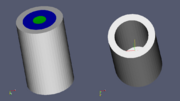Tut Small Study on Conjugate Heat Transfer
Contents
1 heatTransfer
1.1 Problem setup
The problem studied is a hot air flow injected into a container coupled with the heat transfer from the flow to and into the container walls. Numerically, this is solved in a Large Eddy Simulation framework, with a one equation transport model for the subgrid turbulent kinetic energy.
2 Complete Solution
The first approach was to take into account both domains, and to solve two different sets of equations:
2.1 Compressible fluid flow



2.2 Heat conduction in the solid domain

The written solver is called \u201cconjHeat\u201d, and is based on two other existing OpenFOAM solvers, namely \u201crhoTurbFoam\u201d and \u201claplacianFoam\u201d. The sources are accesible through the following link: Media:conjHeat.tgz. The test case consists in a solid can (see Figure 1b), in which a hot fluid (700 K) is injected with 0.1m/s through a small area (green face in Figure 1). The exterior wall surface of the can is kept at a constant temperature of 300 K.
